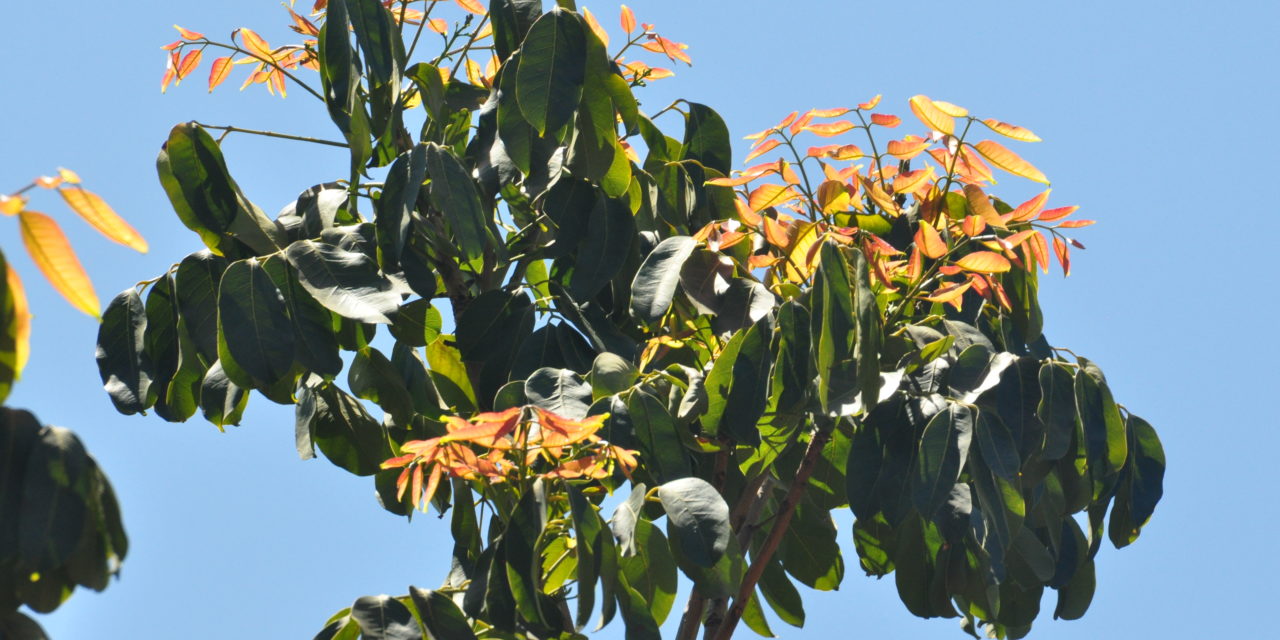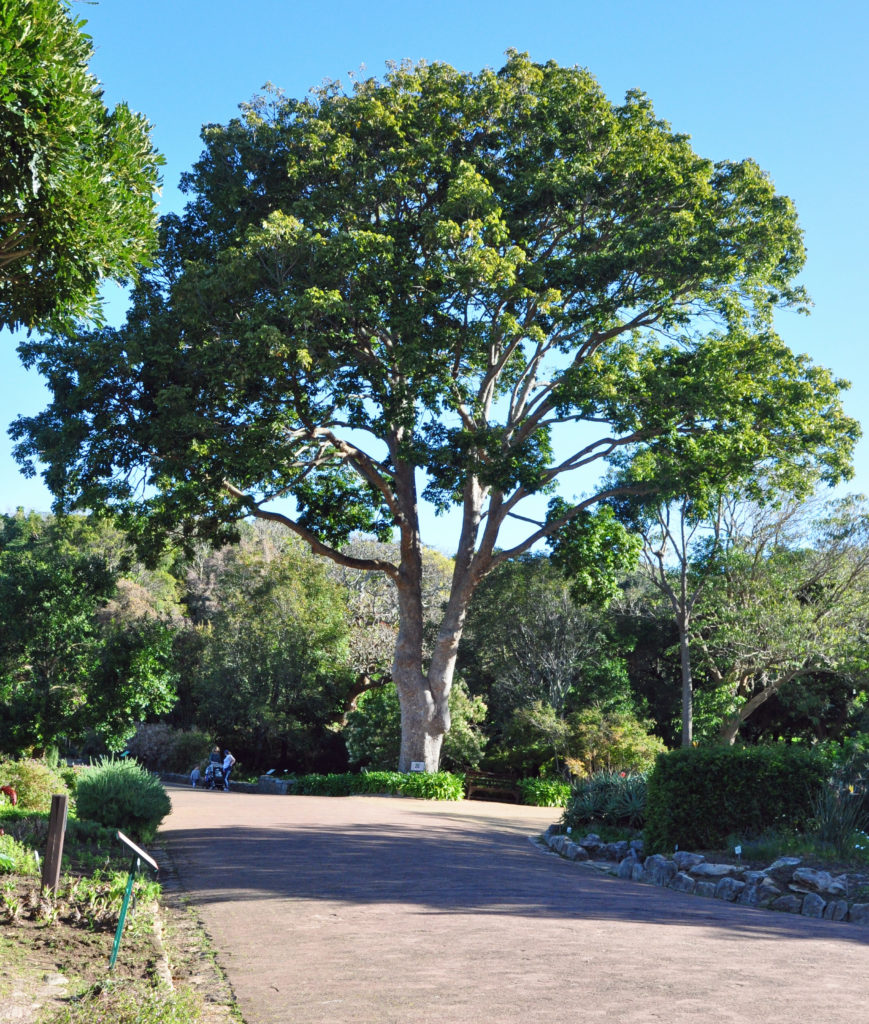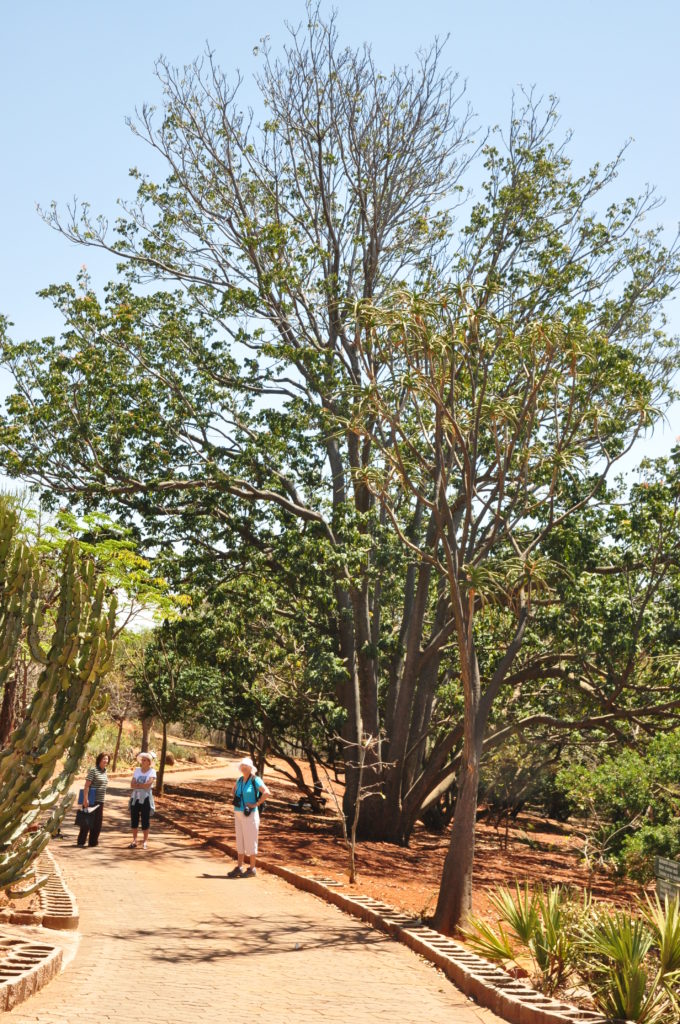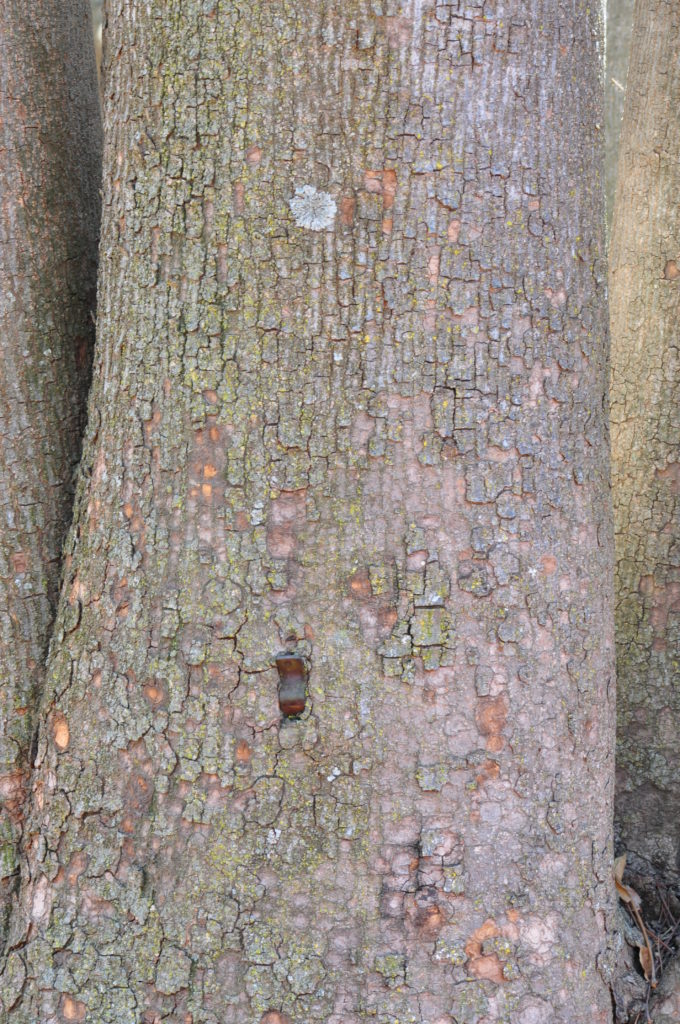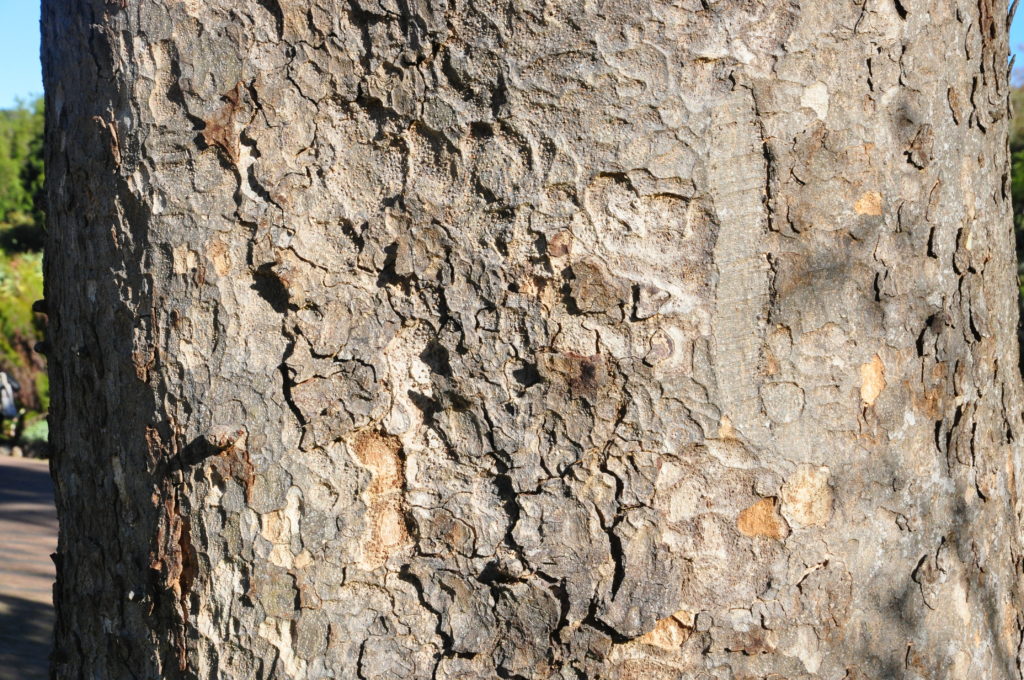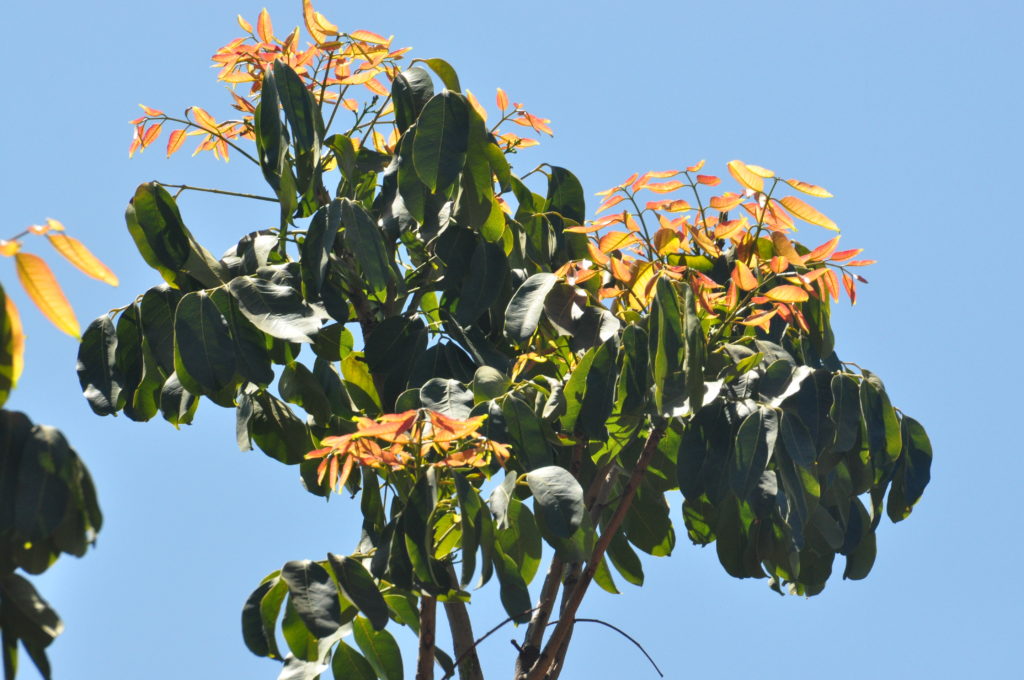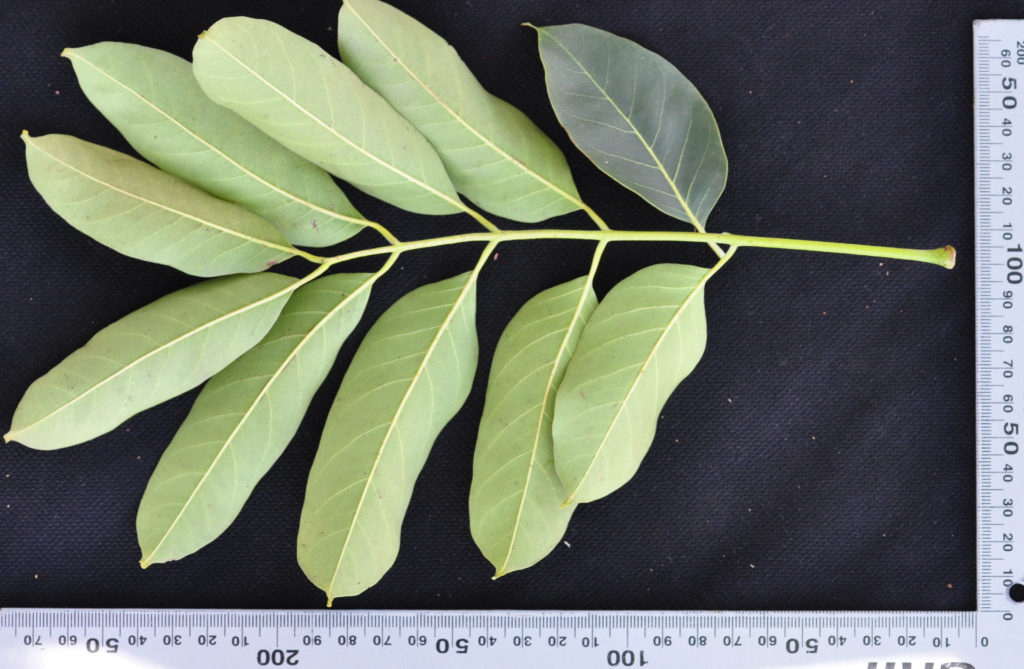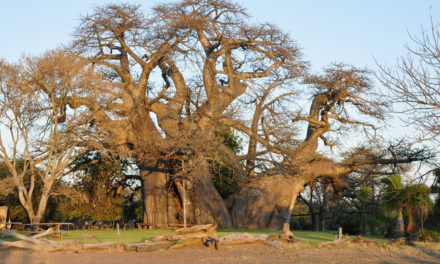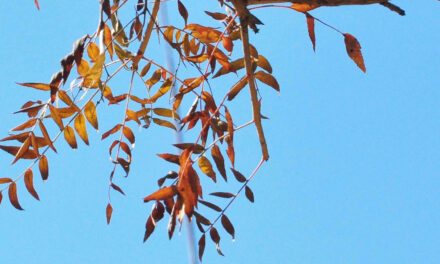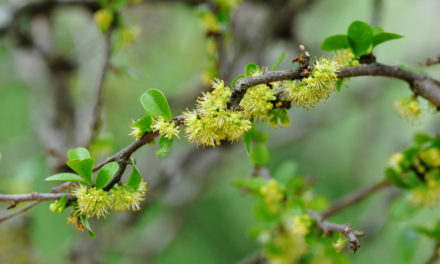General Info – summary
This impressive, large monoecious Tree has a much-branched crown up to 60m high & a trunk diameter up to 1,2m. The paripinnate Leaves lack stipules and have 2-8 pairs of asymmetric, entire leaflets. The white, small, unisexual Flowers are regular and develop in panicles. Male flowers have joined filaments. Female flowers have a superior ovary and a short style. Fruit is a capsule with flattened narrowly winged seeds.
Description
Khaya anthotheca
Previous Names: Khaya nyasica.
SA Tree No. n/a. Zimb. No: 422.
Common names: (Afr) Oos-Afrikaanse mahonie, Rooimahonie. (Eng) Red mahogany, White mahogany, East African Mahogany, Nyasaland mahogany. (French) Acajou. (Manica, Niassa, Sofala) M’baua.
Family: Meliaceae (Mahogany family). This family of mainly shrubs and small trees has 50+ genera and 570+ species. Perhaps the best-known local alien tree in this family is the seringa (The scientific name is Melia azedarach) with its poisonous yellow berries. This tree is considered invasive in South Africa. In southern Africa, there are about 6 genera and 11 species. Those genera with trees on this website include Ekebergia, Nymania, Khaya and Trichilia. Most trees are evergreen and Leaves are large, simple or compound, lack stipules and are usually alternate. They occur in a large cluster or on short shoots. The bisexual or unisexual Flowers are regular, axillary and in panicles (indeterminate, branched inflorescence with stalked flowers) or solitary. The Calyx has 4-5 sepals, which are free to near the base. The Petals are imbricate (having regularly arranged, overlapping edges). The 5 to many Stamens are free except at the base and the Anthers are attached in the middle. The superior Ovary has a simple Style which ends in a disc-like, head-like or lobed Stigma. The Fruit is a capsule or a drupe and may be winged or have a pulpy covering.
Name derivation: Khaya. Khaya is a genus of African timber trees with wood closely resembling mahogany. Info attached to the tree in Kirstenbosch NBG includes – “It is said that the first visiting botanist who saw the tree growing in a forest somewhere in Africa asked the guide what the tree was called. The guide said “khaya” which in his language meant, “I don’t know.” The botanist, not knowing any better, diligently wrote down the name and the genus was named accordingly.” anthotheca – Anthos – Greek meaning flower and theca refers to the capsule. This tree is not indigenous in South Africa but is now a naturalised tree.
Conservation Status: Assessment: 1998. In the IUCN (International Union for Conservation of Nature) Red List, this tree is listed as Vulnerable. The conservation problem is that the tree is greatly sought after for its timber.
Tree
This large, impressive Tree (photos 178 & 787) is usually up to 30m high but may reach 60+ m. The Trunk is 1,2m+ in diameter and may become buttressed with age. The much-branched Crown (photo 787) may be elongated or rounded. Branching occurs high up the trunk. Some leaf scars may be visible on the greyish branchlets. The usually smooth, grey to brown Bark (photo 783) tends to flake in round scales (photo 177).
This large, impressive Tree (photos 178 & 787) is usually up to 30m high but may reach 60+ m. The Trunk may reach 1,2m+ in diameter, and the tree may become largely buttressed with age. The much-branched Crown (photo 787) may be elongated or rounded. Branching occurs high up the trunk and new growth is red. Some leaf scars may be visible on the greyish branchlets. The usually smooth, grey to brown Bark (photo 783) tends to flake in roundish scales (photo 177).
- 178 2018.09.10 Kirstenbosch. Photo: David Becking.
- 787 2016.10.11 Pretoria NBG. Photo: David Becking.
- 783 2016.10.11 Pretoria NBG. Photo: David Becking.
- 177 2018.09.10 Kirstenbosch. Photo: David Becking.
Leaves
Young spring Leaves are yellowish-orange and clustered near the ends of branches (photo 785). Mature leaves are hairless, leathery, spirally arranged and large – up to 33cm long and paripinnate (pinnately compound leaf ending in a pair of leaflets – photo 784). The 2-7 pairs of Leaflets are opposite or nearly so. Each leathery, hairless and oblong-elliptic leaflet is up to 17 x 7cm. The Blade is dark, glossy green above and much lighter below (photo 784). The 6-10 pairs of Side veins are visible on both surfaces (photo 784). The Margin is smooth, rolled under and entire (with a continuous margin, not in any way indented). The Apex is round to tapering and may end abruptly. The tip is sharply pointed (photo 784) or rounded. The slightly asymmetric Base (photo 784) is broadly tapering to rounded. The slender Petiole (leaf stalk: 3,5-7cm long) has a swollen base and is up to 7cm long. Petiolules (leaflet stalks) are slender and 0,5-1,5cm long. Stipules (basal appendages of the petiole) are absent.
- 785 2016.10.11 Pretoria NBG. Photo: David Becking.
- 784 2016.10.11 Pretoria NBG. Photo: David Becking.
Flowers
This tree is monoecious (having both male and female reproductive organs on the same plant). The inconspicuous individual Flowers are unisexual and develop in leaf axils. They are whitish, sweet scented and actinomorphic (Regular, symmetrical. Flowers are vertically divisible into similar halves by more than 1 plane passing through the axis). Large numbers develop, towards the ends of branches in up to 15+cm long axillary Panicles (indeterminate, branched inflorescences with stalked flowers). Separate male and female flowers have well-developed sterile parts and are very similar. Each flower is small – up to 1cm wide and rests on a short Pedicle (stalk of a single flower: 1,5-3mm long). The Floral parts are in 4’s or 5’s. The Calyx is small (1-1,5mm long) and the Sepals are joined close to the base and never completely cover the corolla in the bud. The Corolla contains free, erect, twisted, somewhat hooded Petals up to 6 x 4mm. Male and female flowers are very similar – both have sterile opposite sex parts present. Male Flowers have about 6mm long joined Filaments. The staminal, urn-shaped tube may reach 6mm in length. It has a swollen middle and narrowing top. 8-10 anthers are present. The Disc (a more or less fleshy or elevated development of the receptacle) is cushion shaped in male flowers. It is less conspicuous in Female Flowers. Here there is a single Pistil (a unit of the Gynoecium, the female element of the flower, composed of the Ovary, Style and Stigma). The superior Ovary has 4-5 locules – each with 12-18 ovules. There is a single short Style and the Stigma has a disc shaped head. (Sep-Dec).
Fruit
The ovate and erect Fruit is a creamy brown, woody Capsule (a dry fruit resulting from the maturing of a compound ovary – of more than one carpel – usually opening at maturity by one or more lines of dehiscence). It is up to 6cm in diameter and splits into 4-5 valves (the units or pieces into which the capsule splits or divides in dehiscing). From here, the many, narrowly winged and strongly flattened Seeds are dispersed. (Mar-Sep).
Distribution & Ecology
The ideal Location for these trees is in evergreen forests at medium to low altitudes riverine forests– up to 1 500m, where the rainfall is in excess of 1 200mm per annum. They also occur in fringe forests close to rivers. Countries in which they occur include Zimbabwe (e.g., Chirinda Forest – near Mount Selinda – close to the Mozambique boarder), Mozambique – mainly central, Zambia, Tanzania, Malawi, Congo, DRC, Tanzania, Angola and northwards. The African female moth (Heteronygmia dissimilis) lays glossy eggs on the bark of this and other Khaya trees. These develop into hairy larvae, which move mainly to the lower leaves and can almost defoliate the tree. Hypsipyla grandella and H. robusta are shoot borers that can also create major problems. A moth species : Heteronygmia dissimilis feed on the leaves and large numbers can defoliate a mahogany tree. Leaves are also consumed by the larva of the White-barred Emperor (Charaxes brutus natalensis) – an attractive, widespread butterfly occurring in southern Africa, up the east coast as well as in Gauteng, Limpopo, Mpumalanga.
Ethnobotany
The bitter tasting Bark is used in local medicine. The reddish brown Wood is hard, and the heartwood is both borer and termite resistant, and weathers well. The wood has a moderate density of about 620kg per cubic metre. It has an attractive grain, takes a good polish and works easily. It saws well and is used for musical instruments, canoe and boat building and excellent furniture making. The wood makes a good fuel, including charcoal. The stem, bark and seeds contain Limonoids, which also cause the bitter taste in citrus fruit. The tree now occurs in plantations in South Africa. These deep shade-producing trees grows up to 1m per year and are easily grown from Seeds.
References
Coates Palgrave, M. 2002. Keith Coates Palgrave Trees of Southern Africa, edn 3. Struik, Cape Town.
Burrows, J.E., Burrows, S.M., Lotter, M.C. & Schmidt, E. 2018. Trees and Shrubs Mozambique. Publishing Print Matters (Pty) Ltd. Noordhoek, Cape Town.
Lawrence, G. H. M, 1951. Taxonomy of Vascular Plants, The Macmillan Company, New York. Tenth Printing 1965.
van Wyk, B. & van Wyk, P. 1997 Field guide to Trees of Southern Africa, Struik, Cape Town.
http://www.digplanet.com/wiki/Heteronygmia_dissimilis
https://en.wikipedia.org/wiki/Khaya_anthotheca
http://www.plantzafrica.com/plantklm/khayaantho.htm
http://www.zimbabweflora.co.zw/speciesdata/species.php?species_id=133440
https://www.ncbi.nlm.nih.gov/pubmed/16462017
http://www.prota4u.org/protav8.asp?p=Khaya+anthotheca
http://posa.sanbi.org/flora/browse.php?src=SP
https://dx.doi.org/10.2305/IUCN.UK.1998.RLTS.T32235A9690061.en. Downloaded on 20 August 2021
http://www.iucnredlist.org//
Khaya anthotheca – Useful Tropical Plants (theferns.info)

